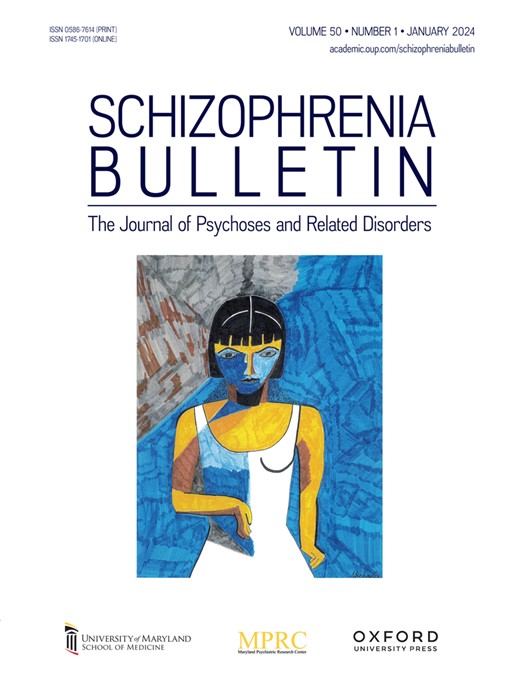IF 5.3
1区 医学
Q1 PSYCHIATRY
引用次数: 0
摘要
背景与假设 思维混乱是精神分裂症的一个突出特征,在出现治疗耐药性的情况下,思维混乱会持续存在。调节自我参照思维的默认模式网络(DMN)的中断现已成为精神分裂症的一个公认特征。然而,我们还不知道DMN的破坏是否会影响精神分裂症患者的思维紊乱并导致耐药精神分裂症(TRS)。研究设计 本研究采用时空方法和静息态功能磁共振成像技术,调查了48名TRS患者、76名非TRS患者和64名健康对照者(HC)的DMN。我们使用多变量组独立成分分析法将 DMN 恢复为一个综合网络,并估算了其负荷系数(反映空间显著性)和香农熵(反映时间可变性)。此外,我们还进行了体素级分析,以检查 DMN 内部的网络同质性和熵。我们使用回归分析探讨了DMN测量与无序化之间的关系。结果 与HC相比,TRS在群体水平的DMN模式上有更高的空间负荷,但熵较低。非TRS患者表现出中等程度的DMN改变,与TRS或HC均无显著差异。TRS和非TRS之间没有体素水平上的差异,强调了两组之间的连续性。DMN的负荷系数在更严重的紊乱患者中更高。结论 TRS 可能代表了精神分裂症患者时空 DMN 功能障碍频谱中最严重的一端。虽然DMN的过度空间贡献(高负荷系数)与精神分裂症的精神紊乱特别相关,但DMN的过度空间贡献和夸大的时间稳定性都是精神分裂症的特征,这些特征在一线治疗无效时会变得更加明显。本文章由计算机程序翻译,如有差异,请以英文原文为准。
Default Mode Network, Disorganization, and Treatment-Resistant Schizophrenia
Background and Hypothesis Disorganized thinking is a prominent feature of schizophrenia that becomes persistent in the presence of treatment resistance. Disruption of the default mode network (DMN), which regulates self-referential thinking, is now a well-established feature of schizophrenia. However, we do not know if DMN disruption affects disorganization and contributes to treatment-resistant schizophrenia (TRS). Study Design This study investigated the DMN in 48 TRS, 76 non-TRS, and 64 healthy controls (HC) using a spatiotemporal approach with resting-state functional magnetic resonance imaging. We recovered DMN as an integrated network using multivariate group independent component analysis and estimated its loading coefficient (reflecting spatial prominence) and Shannon Entropy (reflecting temporal variability). Additionally, voxel-level analyses were conducted to examine network homogeneity and entropy within the DMN. We explored the relationship between DMN measures and disorganization using regression analysis. Results TRS had higher spatial loading on population-level DMN pattern, but lower entropy compared to HC. Non-TRS patients showed intermediate DMN alterations, not significantly differing from either TRS or HC. No voxel-level differences were noted between TRS and non-TRS, emphasizing the continuum between the two groups. DMN's loading coefficient was higher in patients with more severe disorganization. Conclusions TRS may represent the most severe end of a spectrum of spatiotemporal DMN dysfunction in schizophrenia. While excessive spatial contribution of the DMN (high loading coefficient) is specifically associated with disorganization, both excessive spatial contribution and exaggerated temporal stability of DMN are features of schizophrenia that become more pronounced with refractoriness to first-line treatments.
求助全文
通过发布文献求助,成功后即可免费获取论文全文。
去求助
来源期刊

Schizophrenia Bulletin
医学-精神病学
CiteScore
11.40
自引率
6.10%
发文量
163
审稿时长
4-8 weeks
期刊介绍:
Schizophrenia Bulletin seeks to review recent developments and empirically based hypotheses regarding the etiology and treatment of schizophrenia. We view the field as broad and deep, and will publish new knowledge ranging from the molecular basis to social and cultural factors. We will give new emphasis to translational reports which simultaneously highlight basic neurobiological mechanisms and clinical manifestations. Some of the Bulletin content is invited as special features or manuscripts organized as a theme by special guest editors. Most pages of the Bulletin are devoted to unsolicited manuscripts of high quality that report original data or where we can provide a special venue for a major study or workshop report. Supplement issues are sometimes provided for manuscripts reporting from a recent conference.
 求助内容:
求助内容: 应助结果提醒方式:
应助结果提醒方式:


